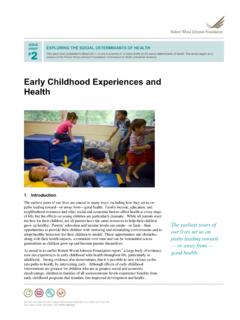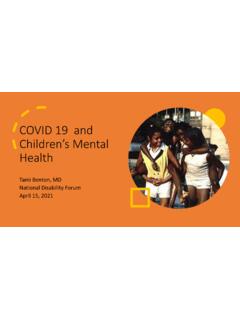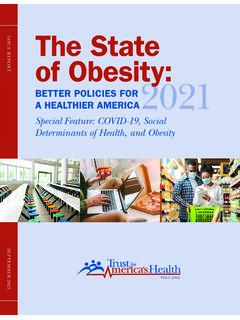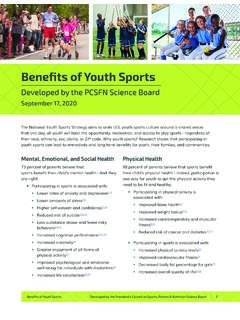Transcription of Scottish Public Health Network (ScotPHN)
1 1 Scottish Public Health Network (ScotPHN) 'Polishing the Diamonds' Addressing Adverse childhood Experiences in Scotland Sarah Couper Phil Mackie May 2016 2 Contents 1. What does the term Adverse childhood Experiences (ACEs) mean? ..6 The original ACE study .. 6 2. What harm dose being exposed to Adverse childhood Experiences cause? ..7 Injury and death during childhood .. 7 Premature mortality and suicide .. 7 Disease and illness .. 8 Mental 10 3. How does being exposed to Adverse childhood Experiences cause harm? .11 Health -harming 11 Social determinants of 12 Neurobiological and genetic pathways .. 13 4. Are there some ACEs that have more of a detrimental effect than others?
2 13 5. Are some people more likely to be affected by ACEs than others? ..15 6. How common are ACEs and can we measure how many people are affected in Scotland?..15 7. What is the economic impact of ACEs in Scotland?..16 8. What can be done about Adverse childhood Experiences? ..18 Creating wider awareness and understanding about 18 Preventing ACEs .. 19 Building Resilience .. 20 Enquiry .. 21 Consideration of children and ACEs in every situation .. 22 Scope for Action in 22 Establishing the priority for addressing ACEs in existing work .. 23 Creating an awareness and understanding about ACEs .. 23 Data collection on ACEs .. 23 Primary Prevention of ACEs .. 23 Secondary Prevention of ACEs .. 24 Tertiary Prevention of ACEs .. 24 Establish Routine Enquiry of 24 References.
3 25 Appendix 1 ..28 3 Acknowledgements We would like to thank the following people for their insights in discussing their work and for providing helpful references: Michael Smith Associate Medical Director for Mental Health NHS Greater Glasgow and Clyde Fiona Crawford Consultant in Public Health NHS Greater Glasgow and Clyde / Glasgow Centre for Population Health Adam Burley Consultant Clinical Psychologist NHS Lothian / City of Edinburgh Council Julia Green NHS Health Scotland Figures 1, 2, & 5 are reproduced from UCL Institute of Health Equity (2015). The impact of adverse experiences in the home on the Health of children and young people, and inequalities in prevalence and effects. See: We understand that these figures are Crown copyright (2015) and subject to the terms of the Open Government Licence To view this licence, visit OGL or email: Figures 3 & 6 are reproduced from an infographic produced by the Centre for Public Health at Liverpool John Moores University.
4 See: content/uploads/2014/05 We are grateful to the Centre for Public Health for permission to reproduce this material. The data is underpinning the infographic is from Bellis MA, Hughes K, Leckenby N, Perkins C, Lowey H. (2014) National household survey of adverse childhood experiences and their relationship with resilience to Health -harming behaviours in England. BMC Medicine 2014, 12:72. 4 Figures 4 & 7 are reproduced from an infographic produced by the Centre for Public Health at Liverpool John Moores University. See: content/uploads/2014/05 We are grateful to the Centre for Public Health for permission to reproduce this material. The data is underpinning the infographic is from Bellis MA, Ashton K, Hughes K, Ford K, Bishop Jand Paranjothy S. Centre for Public Health - Liverpool John Moores University (2016).
5 Welsh Adverse childhood Experiences (ACE) Study - Adverse childhood Experiences and their impact on Health -harming behaviours in the Welsh adult population. This report is 2015 Public Health Wales NHS Trust. Material contained in the report may be reproduced under the terms of the Open Government Licence (OGL). To view this licence, visit OGL or email 5 FOREWORD A very wise, experienced Health Visitor used the analogy, when talking about children that they are like diamonds: their potential is inherent, but they need to be polished with care and attention. Sadly, not all of our children in Scotland are currently being 'polished' with enough care and attention, with a significant number being subjected to Adverse childhood Experiences (ACEs). The aim of this briefing paper is to give an overview of ACEs and to provide an insight into the following questions: 1.
6 What does the term Adverse childhood Experiences (ACEs) mean? 2. What harm dose being exposed to Adverse childhood Experiences cause? 3. How does being exposed to Adverse childhood Experiences cause harm? 4. Are there some ACEs that have more of a detrimental effect than others? 5. Are some people more likely to be affected by ACEs than others? 6. How common are ACEs and can we measure how many people are affected in Scotland? 7. What is the economic impact of ACEs in Scotland? 8. What can be done about Adverse childhood Experiences? On the basis of these considerations, a number of areas for possible Public Health action / intervention are identified for further discussion. Andrew Fraser May 2016 6 1. What does the term Adverse childhood Experiences (ACEs) mean?
7 The term Adverse childhood Experiences was originally developed in the US in the context of the Adverse childhood Experiences (ACE) study1. It has since been the subject of study in numerous other countries and has been accepted to mean: intra-familial events or conditions causing chronic stress responses in the child s immediate environment. These include notions of maltreatment and deviation from societal norms 2 Categories are subdivided into overt abuse, neglect (both physical and emotional) and household adversity (see Table 1). Table 1 Categories of Adverse childhood Experience Abuse Neglect Household Adversity Emotional Abuse Emotional Neglect Domestic violence Physical Abuse Physical Neglect Household Substance Misuse Sexual Abuse Household Mental Ill Health Criminality Separation Living in care The original ACE study The original study of Adverse childhood Experiences1 was conducted in the United States at Kaiser Permanente from 1995-1997.
8 Over 17,000 people, who were patients enrolled with Kaiser Permanente, completed a survey, answering questions about childhood maltreatment, family dysfunction and current Health status and behaviours. A physical examination was also conducted. The study refers to an ACE score, which is the total count of the ACEs reported by each participant. It used 10 questions to calculate an ACE score out of 10 (Seed Appendix 1). 7 It has been recognised that there are other types of adverse experiences in childhood , which are also likely to have similar negative effects on Health , but these ten were the ones used by this study. 2. What harm does being exposed to Adverse childhood Experiences cause? Observed associations between experiencing ACEs and 'ill- Health ' in its widest definition can be divided into four categories:3 injury and death during childhood ; premature mortality and suicide; disease and illness; and mental Illness.
9 Injury and death during childhood Self-harm and suicide have been shown to be more prevalent in the adult populations studied; therefore it is likely that this will be the same in children. Injury rates in childhood have been shown to be more common in areas of socioeconomic deprivation and, therefore, are also likely to be linked to the prevalence of ACEs. However, these are speculative associations as there is a lack of data in this area. Premature mortality and suicide A British study following the 1958 Birth Cohort examined the relationship between experiencing ACEs and premature mortality 50 Men who had experienced 2 or more ACEs had a 57% increased risk of death than men who had experienced no ACEs. The risk for women took the pattern of a graded relationship, a 60% increased risk with one ACE and an 80% increased risk with 2 or more ACEs.
10 Whilst there is little doubt that the experience of ACEs affects both morbidity and premature m o r t a l i t y, whether ACEs could help to explain Scotland's 'excess mortality' has been studied. Negative early years and childhood experiences were compared in Glasgow and the Clyde Valley to similarly socioeconomically deprived areas in England Merseyside and Greater Manchester4. The difficulties of this were 8 acknowledged as many of the measures relied on self-reports by the parents and measures of more extreme aspects of household dysfunction were missing. A paper yet to be published acknowledges the difficulties of trying to investigate this hypothesis using routine data. However, it concludes that the role of childhood adversity and attachment experience merits further investigation as a plausible mechanism influencing Health in An increased suicide risk has been shown to be linked to the presence of childhood adversity by age Disease and illness Experiencing ACEs has been linked to a whole variety of Health harming behaviours and illnesses.





